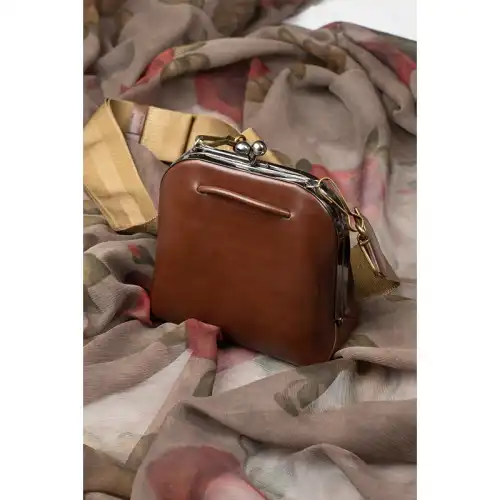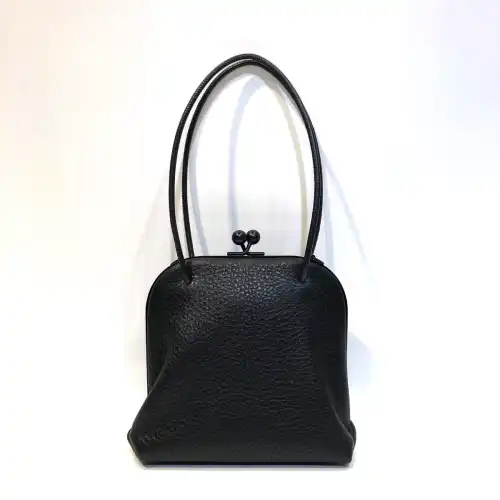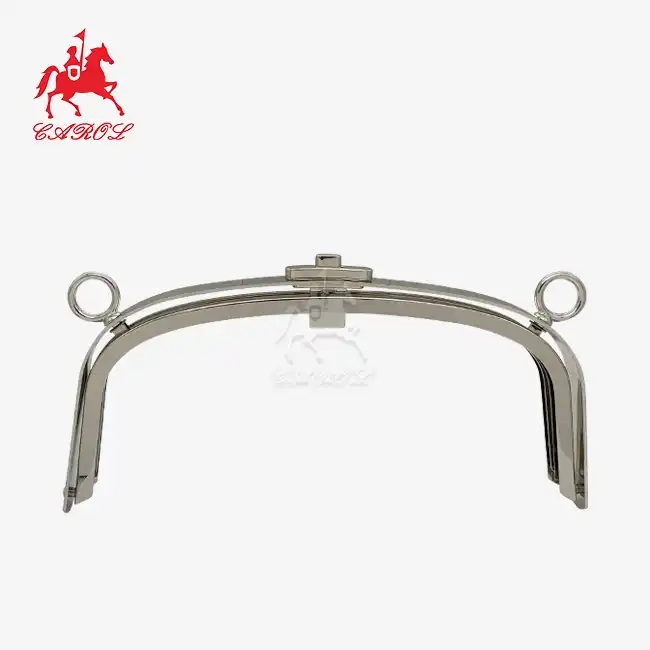Aesthetic design and mechanical perfection come together in the manufacture of bag frames. Several interrelated components come together to offer both structural integrity and practical beauty when looking at a metal clasp purse frame with handle. Over many years, manufacturers have improved these parts by striking a balance between the needs of contemporary fashion sensibilities and durability standards. Every component contributes to the overall functionality of the completed accessory while fulfilling a specific function.
Metal Frame with Integral Handle
The primary structural element consists of the metal clasp purse frame with handle body itself, which forms the opening perimeter of the purse. Constructed typically from iron or zinc alloy, the frame establishes dimensional stability for the entire accessory. To create exact shapes and dimensions, die-casting or metal stamping are used in manufacturing operations. The intended use determines the thickness of the frame; larger purses need thicker gauges, while delicate evening clutches require lighter profiles. Polishing, buffing, and deburring are surface preparation techniques used prior to finishing in order to remove sharp edges that might harm fabric or cause user injuries.
Integrated handles distinguish certain frame designs from simple clasp-only models. Handle attachment represents a critical engineering challenge because this component experiences substantial stress during normal use. Two primary attachment methods dominate the industry: welded connections and mechanical fastening through rivets or screws. Welded handles offer superior strength but limit replacement options if damage occurs. Mechanically fastened handles permit easier repair yet introduce potential failure points at connection interfaces. Handle positioning affects carrying comfort—centered placement provides balanced weight distribution, while offset mounting can create awkward hand positions during extended use.
The curvature and cross-sectional shape of handles merit careful consideration. Circular cross-sections concentrate pressure on smaller hand areas, potentially causing discomfort. Oval or flattened profiles distribute load more effectively across palm surfaces. Some manufacturers incorporate ergonomic contouring that accounts for natural finger positioning, though such refinements increase production complexity. Handle length must accommodate various hand sizes without excessive clearance that allows the purse body to swing freely, striking against legs during walking. Shorter handles force cramped grips, while overly long handles create ungainly proportions.

Frame finishing transforms raw metal into visually appealing components that resist environmental degradation. Thin coatings of ornamental and protective metals are applied to base materials by electroplating methods. Warm tones that are popular in designs with a vintage feel are produced by light gold plating, which is accomplished by carefully immersing the metal in electrolyte solutions. Rose gold, gunmetal, brushed nickel, and antique brass are among other finishes. For each finish to provide sufficient adhesion and consistent coverage, certain chemical preparations and electrical settings are needed. Durability and plating thickness are closely correlated; at high-friction contact locations, thinner layers erode more quickly.
Clasp Mechanisms
Clasp assemblies provide secure closure while permitting quick access to purse interiors. The most prevalent design employs a dual-side mechanism where opposing metal clasp purse frames with handle sections interlock when pressed together. When external pressure or abrupt movements cause an opening, internal spring systems provide the clamping force required to keep the closure in place. A spring's closing force and opening ease must be balanced; too much tension irritates users, especially those with weak hands, while too little tension permits unintentional opening.
Kiss-lock mechanisms represent a specific clasp category characterized by curved frame sections that create an audible clicking sound when engaged. The name derives from the pressing motion required to activate the locking action, similar to pursing lips. Internal ball bearings or shaped detents create physical interference that resists separation until deliberate lateral pressure releases the lock. Such mechanisms excel in vintage and retro designs where the distinctive opening action contributes to aesthetic appeal. However, kiss-lock frames, including the metal clasp purse frame with handle, typically require more precise alignment during assembly compared to simpler frame-and-bar clasp styles.

Alternative clasp designs incorporate twist-lock mechanisms where rotation rather than compression engages the securing elements. Rotating clasps offer advantages in certain applications—they resist vibration-induced opening better than spring-loaded types and provide tactile confirmation of proper engagement. Installation complexity increases because rotation mechanisms require precise angular alignment between mating components. Wear patterns differ as well; rotational friction concentrates at bearing surfaces rather than distributing across spring compression points.
The clasp tongue or bar component extends from one metal clasp purse frame with a handle side to engage with the receiving socket on the opposite side. Manufacturing tolerances for tongue dimensions are crucial because too much width results in binding and makes insertion difficult, while too little width allows for wobbling and poor engagement. Tongue length must give proper insertion depth without projecting unduly, which might harm purse contents or cause snagging problems. By preventing the mechanical wear that comes from thousands of opening and shutting cycles, surface hardening treatments for tongues increase their operational life.
Hinge elements connect the two primary frame halves, enabling the opening motion fundamental to purse functionality. Concealed hinges maintain clean aesthetic lines but complicate manufacturing and limit opening angles. External hinges simplify production yet create visual interruptions along the frame perimeter. Cylindrical pins that insert into matching holes in barrel sections are used in pin-and-barrel hinge construction. Smooth finishing is necessary for barrel bearing surfaces in order to reduce friction and avoid binding. Thrust washers are thin metal disks that certain manufacturers use to reduce axial friction between spinning parts.
Functional Features
Beyond basic closure and carrying capability, a metal clasp purse frame with handles incorporates various functional enhancements. Mounting holes or channels around the frame perimeter provide attachment points for fabric or leather body materials. Hole spacing and diameter accommodate different sewing techniques—running stitches through closely spaced small holes, or whip stitching through larger, more widely separated openings. Some frames feature continuous channels rather than discrete holes, allowing flexible positioning of attachment stitches. Channel depth must provide adequate material engagement without creating bulky seams that prevent proper frame closure.
Interior frame surfaces often include texture or knurling that increases friction against attached materials, preventing slippage under load. Smooth interior surfaces permit easier fabric insertion during assembly but may allow gradual material creep that loosens connections over time. Manufacturers balance these considerations based on intended production methods—hand assembly tolerates rougher surfaces better than automated processes, where fabric feeding requires minimal friction resistance.
Weight optimization represents an ongoing challenge in the metal clasp purse frame with handle design. Heavier frames provide reassuring solidity and improved structural rigidity but increase carry fatigue and shipping costs. Material selection, wall thickness reduction, and strategic perforation patterns allow weight reduction without compromising essential strength. Computer-aided engineering enables stress analysis that identifies regions where material can be removed safely. However, excessive optimization creates frames that perform adequately only under ideal conditions, failing when subjected to abuse or edge-case loading scenarios.
Corrosion resistance varies dramatically based on base material selection and finishing quality. Iron frames without adequate plating thickness develop rust when exposed to moisture, leaving permanent stains on light-colored fabrics. Zinc alloy compositions offer improved corrosion resistance but may suffer from zinc pest—a spontaneous crystalline degradation that occurs under specific temperature and impurity conditions. Stainless steel frames eliminate corrosion concerns entirely but substantially increase material costs and manufacturing difficulty due to greater hardness and work-hardening characteristics.

Compatibility with various purse-making techniques influences the metal clasp purse frame with handle design details. Frames intended for sewn attachment require different edge profiles than those designed for glued assembly. Sewing-compatible frames incorporate rounded edges that don't cut thread during stitching operations, while glue-application frames may feature rougher surfaces that enhance adhesive bonding. Some frames accommodate both attachment methods through dual-purpose edge designs, though such versatility often involves compromises in optimal performance for either technique.
Metal Clasp Purse Frame with Handle Supplier: Carol
Carol Metal specializes in creating personalized metal purse frames for commercial manufacturers, craftsmen, and handbag makers all over the globe. The firm offers full solutions for purse frame hardware needs because to its extensive in-house skills in design, manufacture, electroplating, and packaging. Consistent surface finishing quality is ensured by the facility's specialized electroplating operation while upholding environmental compliance norms.
The featured metal clasp purse frame with handle exemplifies Carol's manufacturing capabilities, measuring 18cm × 11cm with light gold finishing. Constructed from iron and zinc alloy materials, frames accommodate customization requests for alternative sizes, colors, and material specifications. Whether sourcing components for vintage-inspired clutches, contemporary evening bags, or functional daily-use purses, Carol's production expertise addresses diverse application requirements.
Customers looking for trustworthy purse frame suppliers may take advantage of Carol's wealth of manufacturing expertise in hardware accessories. By using precise production techniques, rigorous inspection procedures, and careful material selection, the firm upholds quality standards. The team offers technical advice to guarantee that frame choices are in line with particular project specifications and aesthetic goals from the first design consultation to the last delivery.
Contact Carol Metal directly for quotations and technical specifications at tony@carolxiao.com. The company welcomes inquiries regarding custom frame designs, bulk wholesale orders, and OEM/ODM brand processing arrangements. Whether developing new product lines or sourcing components for established collections, Carol's manufacturing capabilities support projects at various production scales with competitive pricing for quantity orders.
References
- Thompson, R. (2021). Metal Fabrication Techniques in Fashion Accessory Hardware. Journal of Manufacturing Design, 45(3), 127-142.
- Zhang, L., & Park, S. (2022). Electroplating Processes for Decorative Metal Finishing. Surface Engineering Quarterly, 18(2), 89-104.
- Morrison, K. (2020). Mechanical Design Principles for Handbag Hardware Systems. Accessory Engineering Review, 33(4), 203-219.
- Chen, W. (2023). Material Selection in Zinc Alloy Die Casting Applications. Metallurgical Processing Technology, 56(1), 45-61.
- Anderson, M., & Liu, H. (2021). Ergonomic Considerations in Handle Design for Carried Accessories. Human Factors in Design, 29(3), 156-173.
_1753256285958.png)

_1754990596544.webp)









